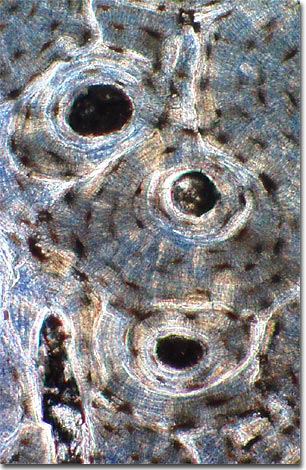Phase Contrast Image Gallery
Human Bone
Bone is a living tissue composed principally of collagen and calcium phosphate. At the microscopic level, it consists of hardened material interspersed with one or more of four different bone cell types, osteoblasts, osteocytes, osteoclasts, and undifferentiated bone mesenchymal cells.

There are two types of bones. Compact bone is dense and hard on the outside and makes up most of the arm and leg bones. Spongy (cancellous) bone has an internal honeycomb design that is designed to withstand stress from several directions and makes up bones such as the pelvis, ribs, and vertebrae.
Perhaps the greatest mystery about bones is why they evolved in the first place. It seems obvious that a rigid endoskeleton plays an important role in the lives of terrestrial animals. Bones support the actions of muscles and protect vital organs such as the brain, heart, and lungs. Yet these functions aren't necessary in an aquatic environment, which is where these rigid skeletons first evolved -- in the bony fishes. As the success of sharks has demonstrated, a skeleton of cartilage works just fine.
Why bones evolved probably has to do with their physiological functions and the advantages they confer. Unlike cartilage, bones are connected with and nourished by the circulatory system. Bones are, in fact, intricately involved with the body's physiology. They provide a protected site, bone marrow, for the formation of red blood cells, blood platelets, and some white blood cells. They are also internal reservoirs of calcium and phosphate, minerals essential for the activity of nerve and muscle cells, and which are regulated by the endocrine system.
Adult humans have 206 bones, accounting for 14 percent of the body's total weight. The thighbone is the longest and strongest bone, about 20 inches (50 cm) long, and the stirrup bone in the middle ear is the smallest, about 0.07 inches (0.18 cm) long. Bone tissue is constantly being utilized and restored by the body, according to the body's demands. If bones lose calcium because of disease, poor nutrition, or drug abuse, they will weaken and break easily.
BACK TO THE PHASE CONTRAST GALLERY
